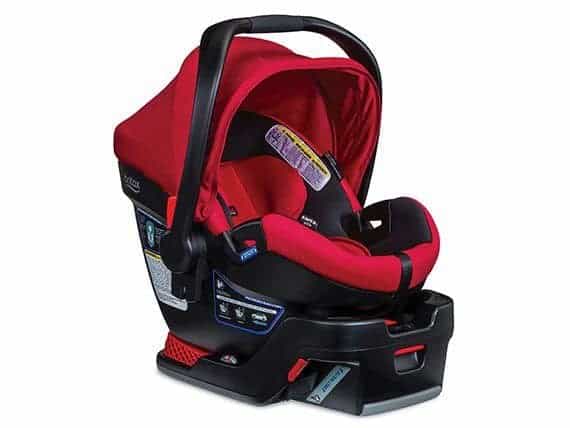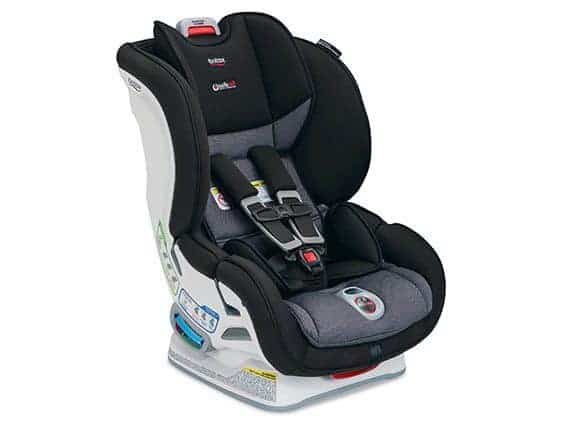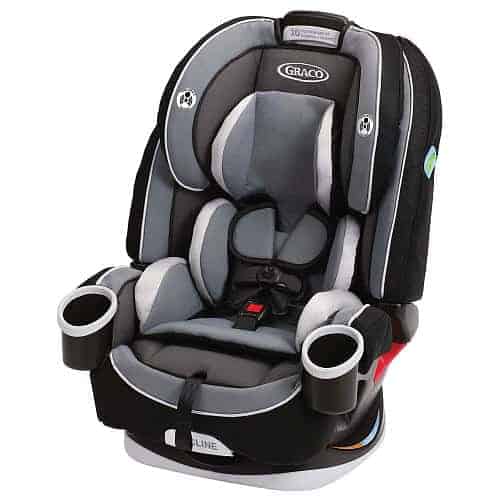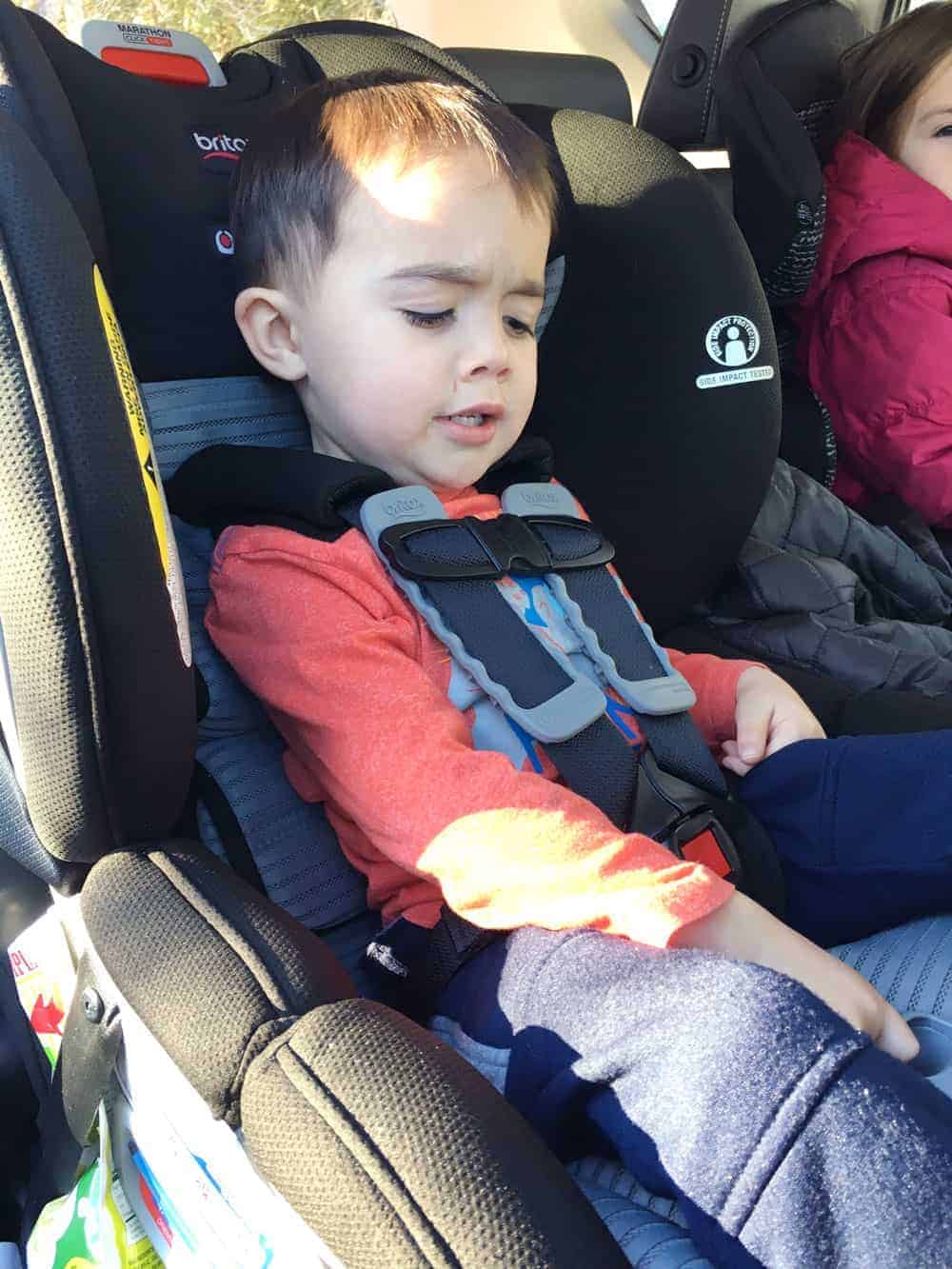When it comes to baby car seats, it might feel like you’ve got a million and one choices to make. So I’ve put together a little list to get you started.
Start with the Basics:
You basically have three styles to choose from for your newborn: infant car seats, rear-facing convertible car seats or all-in-ones. All are considered safe, but let’s break down the differences between these three types of seats.

Infant Car Seats
These seats are the traditional ‘bucket’-style seats that only face the rear of your car. They’re the ones you see new moms everywhere lugging to and from coffee shops – and they generally fit babies well for the first year (especially wee newborns). They’ve got the added handy feature of easily clicking into and out of a base in your car and your stroller.

Convertible Car Seats
These ones stay in your car and will last from newborn up to about 35 or 50 pounds and 32 to 35 inches tall (your child’s head should be 1” below the top of the seat). Since the American Academy of Pediatrics recommends children ride in rear-facing seats as long as possible, this style of car seat can save you from having to purchase another one as your baby grows.

All-in-1 Car Seats
These are another type of seat that can change from rear-facing with a harness to forward-facing with a harness and then into a booster seat with the seatbelt. It’s important to make sure you check it out carefully when buying though, because some All-in-1 car seats are forward-facing only and that’s no bueno for babies.
Personally, I got an infant seat then moved to a rear facing convertible when my baby got too big to lug around. On the surface, the convertible seems like a great idea from the start because you skip the infant seat, but trying to move a sleeping infant in and out of the car seat tends to be a real pain in the butt.
There’s something to be said for snapping a sleeping baby into a stroller system without disturbing them – especially in those early walking dead days. (Just try not to use your car seat as a sleeping place for your baby when you’re at home – it’s not recommended).
Key Features
So this is where it can get overwhelming. As a new parent, the tendency may be to look for the fully-loaded Rolls Royce version of the baby car seat. But here are a few of the features that may affect which seat you buy.
- Width and Length. If you have a very tight back seat or you're a tall person who needs the driver seat far back, not all seats will work in your car if they are tall.
- No Thread Harness. It’s nice to be able to adjust the headrest and harness together with one hand. Rethreading is a bit of a pain but you don't have to do it that often.
- An anti-rebound bar at the foot of the seat. It helps to limit the amount of movement during a crash.
- Load Leg. It improves stability and helps absorb some of the force from a crash.
- A larger canopy. This one is a nice bonus for both in and out of the car to protect your kiddo from the elements and dirty stranger hands.
- Belt Lock-Off. This is when you simply use your vehicle’s seat belt with the base and it snaps down to lock it down gorilla tight.
- Minimum weight. Many brands focus on the upper limits for weight and height but odds are you will move to another car seat before your child hits those limits. However, if you're having multiples or think you might have a very small baby, keep an eye on those lower limits. Not all seats can accommodate a super wee baby.
Safety & Usage Info
- All authentic seats are safe. All new car seats on the market have to be tested and approved for the current safety standards (you’ll find the safety mark or stamp on the box) so don’t let slick salespeople tell you that you have to drop a fortune on a car seat if you really don’t have the budget – any car seat you buy new is safe. (This does not apply to knockoffs - make sure the seat you buy is authentic and from a reputable source. A $400 car seat will never sell for $50. Don't buy it.)
- Know the history. When it comes to secondhand car seats, make sure you know the history. You’ll want to ensure they haven’t been involved in any accidents and aren’t a model that’s been recalled in the past. I wouldn’t recommend buying these out of the trunk of someone’s car – if you’re going to get it used, get it from someone you trust.
- Car seats have varying expiration dates. They can range from 4-10 years depending on make and model. They have an expiration date because plastic weakens and becomes brittle over time.
- Brush up on common car seat no-nos. They can be more common than you’d think – so don’t beat yourself up for not knowing some of these seemingly intuitive things (car seats can be so confusing).
- Don’t use LATCH and a seat belt together. Use one or the other. You can read more about it here.
Where's the safest spot in the car to install an infant car seat?
The ideal place to install an infant car seat is in the center so there is more space around that kiddo on all sides. However, it is a colossal pain to lift a seat out of that spot, and a car tech once told me that most crashes are front and rear, so next best spot is the rear passenger side. That way if you ever have to get out on the street you are lifting your kid onto the sidewalk – not into traffic. End of the day, as long as the seat is correctly installed, rear facing and in the back seat, you are good to go.
Handy Tips
- Try to get this piece of baby gear before your due date – this is not something you want to be installing in the hospital parking lot. (A handy guideline is to aim to have it, install it and know how to use it by about 6 weeks before your due date).
- Test it out in your car before you cut the tags off to see if it fits. If it ends up rendering the passenger seat useless, it isn’t working in your ride. Fit with your car is one of the most important things to consider when choosing your car seat.
- Fill out and return the Registration Card that comes with your seat so that the manufacturer can inform you of any safety notices or recalls. It’s not a scam.
- A larger weight limit doesn’t mean a better seat – most kids outgrow the height limit before the weight limit anyway.
- Find a car seat tech in your area at safekids.org, csftl.org or car-seat.org (I paid to have my seat installed, and it was the best money I ever spent.)
Clear as mud?? I hear ya. I know about this stuff and I’m still overwhelmed. So I put together a quick little quiz for you to help get you started. It’s not the mother of all quizzes (I nearly had all the results point to “just walk”) but it will at least narrow down some options. Let me know what you think though.
My Top 5 Infant Car Seats
Here are some of my favorite infant car seats to get you started.
Best for a Tight Fit - Clek Liing
- 🟢 Great if you need to fit 3 kids across in the back seat
- 🟢 It's very compact so perfect for tall drivers or tight back seats
- 🟢 The lowest harness setting fits very small babies, so it's a good choice if you're expecting a small newborn (like multiples)
- 🟢 If you aren't in the same car all the time (Rideshare, Taxis, multiple cars, etc.) you don't need to buy the base – it has lower anchors attached right to the seat
- 🔴 It's pricey
Best for Extra Safety bells & whistles - Nuna Pipa RX
- 🟢 The base has the anti-rebound bar (ARB) built right into it
- 🟢 Includes a load leg
- 🟢 Can be installed with European or American belt routing
- 🟢 Easy to install and work with many stroller bases
- 🔴 Make sure your vehicle can accommodate a load leg
Best for Affordability - Evenflo LightMax 35
- 🟢 Fits small babies VERY well – starting weight is 3 lbs
- 🟢 It's pretty light if you need to haul it around a lot
- 🟢 Super easy to install
- 🟢 Relatively affordable
- 🔴 It needs a 1.5" clearance at the top so it's not great for tight spaces
Best Stroller Combo - Doona Infant Car Seat
- 🟢 Handle works as an anti-rebound bar
- 🟢 Great if you're going to be in and out of a car a lot or use rideshares and taxis often
- 🔴 It doesn't fit preemies well
Best No Brainer - Graco SnugRide SnugFit 35 DLX
- 🟢 Solid seat that will work for most families
- 🟢 Simple install
- 🟢 Relatively affordable
- 🟢 No-rethread harness and a built in anti-rebar
- 🔴 Trickier install without the base
How did you end up picking your infant car seat?
Was it a struggle or an easy decision? Let me know in the comments below.
You might also like: New Baby Checklist - What to Put on Your Registry




Leave a Comment